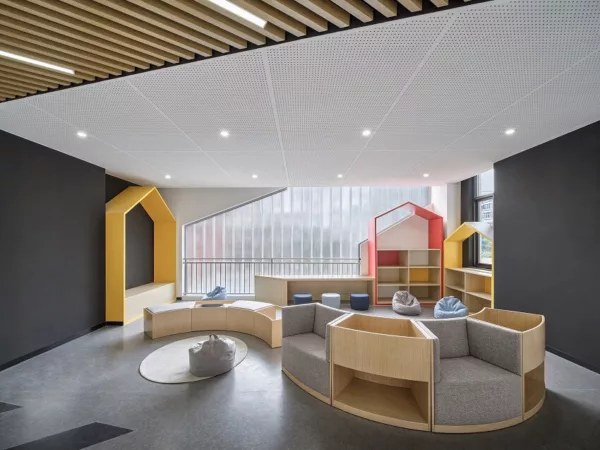
Song Chen: Innovating Educational Spaces with LINEWORKS Studio

Song Chen, a founder of LINEWORKS Studio, has played a key role in transforming educational environments through innovative design. Established in 2007, LINEWORKS Studio, based in Shanghai, has consistently aimed to improve life experiences through thoughtful spatial design. Their award-winning project, “Jinshan No. 2 Experimental Primary School,” located in Shanghai, China, highlightes their commitment to creating functional, engaging, and inspiring spaces. We had the opportunity to speak with Song Chen about their approach and the inspirations behind their remarkable work.
Could you give us a little background on yourself or your company?
Song Chen: LINEWORKS Studio was founded in 2007 and is based in Shanghai. We are dedicated to designing and creating spaces that enrich people’s life experiences. Our content-driven approach helps us create environments that appeal not only to the eyes but also to all senses and the minds of the people within the space. With over ten years in Shanghai, we understand the complexities of building in China and have gained experience in various areas such as education, catering, and workspace. We provide a range of services from project conception to completion, welcoming diversity and coordinating with collaborators from various fields. Our comprehensive and innovative design solutions make us stand out.
What was the brief for the award-winning project?
Song Chen: As contemporary Chinese society continues to modernize, the demand for quality education is rising. The definition of core competencies in Chinese primary schools has shifted from basic learning skills to the cultivation of comprehensive learning skills. Commissioned by Shanghai Jinshan No. 2 Experimental Primary School, our team designed a new interior space for its South campus. We identified the need for active, social-friendly, and personalized learning spaces through in-depth discussions with the school. Despite some initial concerns from teachers about the unfamiliarity of the new spaces, we proceeded to address these needs in our design.

Please describe the design process. How was it resolved?
Song Chen: Understanding the school’s needs and concerns, we developedthe interior design of subject-based classrooms on each floor of the new building. We replaced walls between some classrooms and public spaces with transparent folding sliding doors, transforming hallways into informal teaching spaces. Inspired by the colors of Jinshan, we boldly applied these to the interior ceilings, walls, and flooring. We used simple and childlike visual elements to expand possibilities for a rich and varied scenario-based curriculum. Child-friendly sailor windows and capsule shapes were chosen for classroom observation windows to encourage students to observe activities outside. The campus radio station features a bright red and yellow archway, creating an optical illusion and blurring the boundary between spaces. The design integrates functional and joyful elements, from microphone-shaped lights to sound absorption panels. Music and dance lesson spaces have transparent glass folding doors, inviting audiences to engage with the performances inside. The reading center features light films on the ceiling, cartoon huts, open bookshelves, and comfortable seating, creating an inviting and expandable space for reading.

What challenges were faced throughout the process?
Song Chen: We faced the challenge of overturning the uniformity of traditional teaching spaces to make them more flexible and diverse, promoting open learning through design. Creating situational teaching spaces to encourage inquiry-based learning and utilizing indoor public spaces for learning activities were primary concerns. Our design aims to increase interaction between spaces and users, inspiring illuminating learning experiences.
What is most outstanding or innovative about the project?
Song Chen: The careful design of subject-based classrooms on each floor is a key innovation. Replacing walls with transparent folding sliding doors and transforming hallways into informal teaching spaces meets the school’s demand for social and personalized learning. The bold application of Jinshan’s colors and the simple, childlike visual elements expand the possibilities for a varied curriculum.

What outcomes of the project are you most proud of?
Song Chen: We are proud of how the new space echoes the school’s educational philosophy, combining regular and situational teaching, social-friendly inquiry, and personalized learning. The design enhances the curriculum, inspires diverse learning experiences, and creates a space of leisure, solitude, and growth.
What led you to become an architect specializing in interior design?
Song Chen: Our dedication to designing and creating spaces that enrich people’s life experiences drives us.
Who are your biggest influences or who do you most admire in architecture and interior design?
Song Chen: Renzo Piano is a significant influence on our work.
If you could own any building or design object in the world, what would you choose and why?
Song Chen: The Jean-Marie Tjibaou Cultural Center by Renzo Piano integrates high technology with the surrounding environment harmoniously.
What future trends, technologies, social changes, or other influences do you feel will have a major impact on your discipline?
Song Chen: Low-carbon lifestyles and AI technology will significantly impact our design process. Sustainability and the exploration of interesting spatial experiences will be increasingly important.
How can your discipline make a real difference to society and the world?
Song Chen: Interior design serves users by meeting their basic needs while subtly guiding and changing behavior and communication habits within the space. This natural and smooth influence enhances the user experience.
How do you feel about receiving an Architecture MasterPrize? What difference do you feel it will make to your future or the future of your company?
Song Chen: Receiving an Architecture MasterPrize is a great honor, recognizing and rewarding our diligent design efforts. It motivates us to invest in more innovation and focus on future projects, strengthening our commitment to creating spaces that enrich people’s life experiences. This honor also increases our visibility and provides opportunities for mutual communication.

We thank Song Chen for sharing insights into LINEWORKS Studio’s exceptional work on Jinshan No. 2 Experimental Primary School. Their dedication to creating meaningful and innovative educational spaces is inspiring, highlighting the significant impact of thoughtful design on learning environments.
